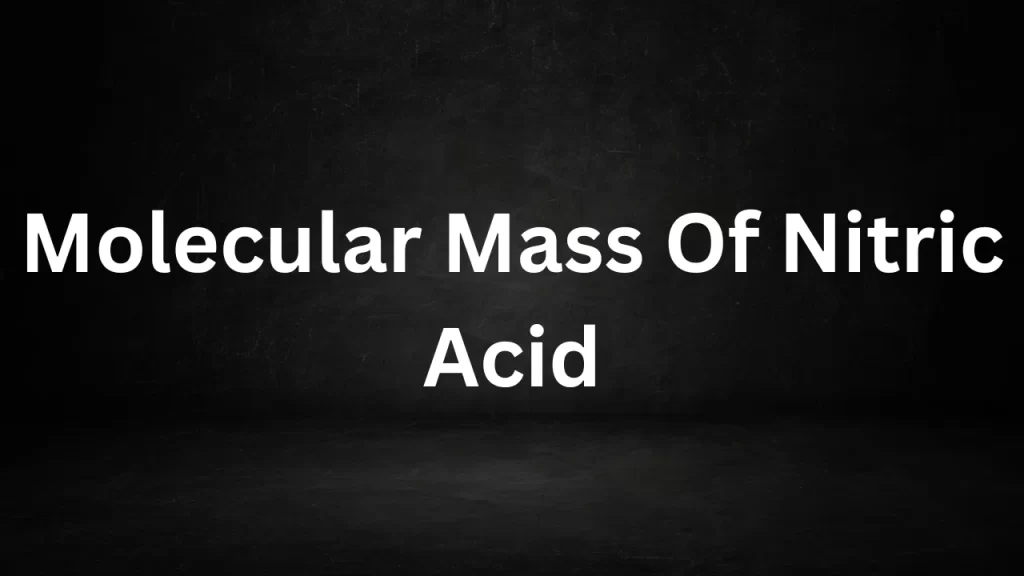Tag: molecular weight nitric acid
Molecular Mass Of Nitric Acid
Molecular Mass Of Nitric Acid: Nitric acid (HNO3) is a highly corrosive and essential chemical compound used in various industrial applications, including the production of fertilizers, explosives, and cleaning agents.
Understanding nitric acid’s molar mass is crucial in chemistry, impacting stoichiometry, reactions, and laboratory procedures significantly. This article delves into molecular mass, its significance in chemistry, and the calculation of nitric acid’s (HNO3) molecular mass.
Molecular Mass Of Nitric Acid
Molecular Mass: A Fundamental Concept
The Molecular mass, also known as mole weight or molar mass, is a fundamental concept in chemistry. It represents the mass of one mole of a substance and is expressed in atomic mass units (amu) or unified atomic mass units (u). The molecular mass of a compound is calculated by summing the atomic masses of all the atoms in its chemical formula, considering the number of atoms of each element.
Calculating the Molecular Mass of Nitric Acid
To find the molecular mass of nitric acid (HNO3), we sum the atomic masses of hydrogen (H), nitrogen (N), and oxygen (O) within the chemical formula.
- Hydrogen (H): The atomic mass of hydrogen is approximately 1.01 amu.
- Nitrogen (N): The atomic mass of nitrogen is approximately 14.01 amu.
- Oxygen (O): The atomic mass of oxygen is approximately 16.00 amu.
Now, let’s calculate the mole mass of nitric acid:
Molecular Mass of HNO3 = (1 × Atomic Mass of H) + (1 × Atomic Mass of N) + (3 × Atomic Mass of O) Molecular Mass of HNO3 = (1 × 1.01 amu) + (1 × 14.01 amu) + (3 × 16.00 amu) Molecular Mass of HNO3 = 1.01 amu + 14.01 amu + 48.00 amu Molecular Mass of HNO3 = 63.02 amu
So, the mole mass of nitric acid (HNO3) is approximately 63.02 amu.
Significance of Molecular Mass of Nitric Acid
The mole mass of nitric acid is significant for several reasons:Stoichiometry:
- It is crucial in stoichiometry, helping chemists balance chemical equations and calculate the amount of reactants and products involved in chemical reactions involving nitric acid.
- Laboratory Work: In laboratories, scientists use the mole mass to measure and prepare solutions of nitric acid with specific concentrations for experiments and analyses.
- Industrial Applications: Industries rely on the mole mass to ensure precise measurements and control processes involving nitric acid, such as in the production of fertilizers, explosives, and chemical manufacturing.
- Safety Precautions: Understanding the mole mass is essential for handling nitric acid safely, as it helps in determining appropriate safety measures and precautions due to its corrosive nature.
Conclusion
The molar mass of nitric acid (HNO3) is a fundamental concept in chemistry, with essential roles in labs and industries. Calculating molecular mass aids chemists in understanding nitric acid’s behavior and composition, ensuring precise control in chemistry and industry.
Read More
- Molecular Mass Of Sulphuric Acid
- Molar Mass Of Sulphuric Acid
- Types Of Motion In Physics
- Kinetic Energy Class 9
- Molecular Weight of AgNO3
Frequently Asked Questions (FAQs) On Molecular Mass Of Nitric Acid
1. What is the chemical formula for nitric acid?
The chemical formula for nitric acid is HNO3, representing one hydrogen atom (H), one nitrogen atom (N), and three oxygen atoms (O) in a single molecule.
2. What is molecular mass, and why is it important in chemistry?
Molecular mass, also known as mole weight or molar mass, is the mass of one mole of a substance expressed in atomic mass units (amu) or unified atomic mass units (u). It is crucial in chemistry as it helps determine the quantity of substances involved in chemical reactions and stoichiometry.
3. How is the molecular mass of nitric acid calculated?
The mole mass of nitric acid (HNO3) is calculated by adding the atomic masses of hydrogen (H), nitrogen (N), and oxygen (O) atoms in the chemical formula, considering their respective proportions.
4. What are the atomic masses of the elements in nitric acid?
The approximate atomic masses are:
- Hydrogen (H): 1.01 amu
- Nitrogen (N): 14.01 amu
- Oxygen (O): 16.00 amu
5. What is the molecular mass of nitric acid (HNO3)?
The mole mass of nitric acid is approximately 63.02 amu.
Molecular Weight Of HNO3
Molecular Weight Of HNO3: The molecular weight of a chemical compound is a crucial concept in chemistry, as it provides insights into its physical and chemical properties. In this article, we will explore the molecular weight of nitric acid (HNO3), a highly important and versatile compound used in various industrial processes and laboratory applications.

Molecular Weight Of HNO3
The Basics of Molecular Weight
Before we delve into the molecular weight of nitric acid, it’s essential to understand the basic concept of molecular weight.
Molecular Weight (Molar Mass): Molecular weight, also known as molar mass, is the mass of a molecule expressed in atomic mass units (amu) or grams per mole (g/mol). It is determined by adding together the atomic masses of all the atoms that comprise a molecule.
For example, the molecular weight of water (H2O) is calculated by adding the atomic masses of two hydrogen atoms (H) and one oxygen atom (O). The atomic mass of hydrogen is approximately 1.008 amu, and that of oxygen is about 15.999 amu. Therefore, the molecular weight of water is approximately 18.015 amu or 18.015 g/mol.
Nitric Acid (HNO3): An Overview
Nitric acid, represented by the chemical formula HNO3, is a strong and highly corrosive mineral acid. It is commonly known as “aqua fortis” and plays a significant role in various industrial processes and chemical laboratories. Here’s a brief overview of its molecular structure:
- H: Hydrogen (Atomic Mass ≈ 1.008 amu)
- N: Nitrogen (Atomic Mass ≈ 14.01 amu)
- O: Oxygen (Atomic Mass ≈ 15.999 amu)
The molecular formula of nitric acid (HNO3) tells us that it contains one hydrogen atom (H), one nitrogen atom (N), and three oxygen atoms (O).
Calculating the Molecular Weight of HNO3
To calculate the molecular weight of nitric acid (HNO3), we sum the atomic masses of its constituent elements:
- Atomic mass of hydrogen (H) ≈ 1.008 amu
- Atomic mass of nitrogen (N) ≈ 14.01 amu
- Atomic mass of oxygen (O) ≈ 15.999 amu
Now, we can calculate the molecular weight of HNO3:
Molecular Weight of HNO3 = (Number of H atoms × Atomic mass of H) + (Number of N atoms × Atomic mass of N) + (Number of O atoms × Atomic mass of O)
Molecular Weight of HNO3 = (1 × 1.008 amu) + (1 × 14.01 amu) + (3 × 15.999 amu)
The Molecular Weight of HNO3 ≈ 1.008 amu + 14.01 amu + 47.997 amu
Molecular Weight of HNO3 ≈ 63.015 amu
So, the mole weight of nitric acid (HNO3) is approximately 63.015 atomic mass units (amu) or 63.015 grams per mole (g/mol).
Significance of Molecular Weight in Chemistry
The molecular weight of a compound is a fundamental parameter in chemistry with several significant implications:
- Stoichiometry: Mole weight assists in establishing the stoichiometry of chemical reactions, aiding chemists in the balancing of equations and the computation of reactant and product quantities.
- Molar Mass: The molar mass, expressed in g/mol, allows chemists to relate the mass of a substance to the number of moles it contains. This is crucial for precise measurements in laboratory work.
- Chemical Analysis: Mole weight is essential in techniques such as mass spectrometry and nuclear magnetic resonance (NMR) spectroscopy, aiding in the identification and characterization of chemical compounds.
- Chemical Formulas: Mole weight helps in verifying the correctness of chemical formulas and determining the composition of compounds.
- Chemical Reactions: Molecular weight influences reaction kinetics and the energetics of chemical reactions.
Conclusion
The mole weight of nitric acid (HNO3) is approximately 63.015 amu or 63.015 g/mol. Understanding the mole weight of chemical compounds is fundamental in chemistry, enabling scientists and researchers to make precise calculations, conduct accurate analyses, and gain insights into the behavior of substances in various chemical processes. Nitric acid, with its diverse applications, exemplifies the importance of mole weight in practical chemistry.
Read More
- Molecular Mass Of Phosphorus
- Molar Mass Of Barium
- Benzoic Acid Molecular Weight
- Molecular Mass Of Cl
- Molecular Weight Of N2
Frequently Asked Questions (FAQs) On Molecular Weight Of HNO3
1. What is the molecular weight of HNO3?
The mole weight of nitric acid (HNO3) is approximately 63.015 atomic mass units (amu) or 63.015 grams per mole (g/mol).
2. How is the molecular weight of HNO3 calculated?
To determine the mole weight of HNO3, one adds the atomic masses of its component elements: hydrogen (H), nitrogen (N), and oxygen (O). The atomic masses are approximately 1.008 amu for H, 14.01 amu for N, and 15.999 amu for O.
3. Why is the molecular weight of HNO3 significant in chemistry?
The molecular weight of a compound is essential in chemistry for various reasons. It allows chemists to determine stoichiometry, calculate reactant and product quantities, analyze chemical reactions, identify compounds using techniques like mass spectrometry, and verify chemical formulas.
4. What is the common name of HNO3?
The common name for nitric acid is HNO3. It is recognized as a potent and extremely corrosive mineral acid.
5. What are the primary uses of nitric acid (HNO3)?
Nitric acid has diverse industrial applications, including the production of fertilizers, explosives, dyes, and pharmaceuticals. It is also used for cleaning and etching metals, as well as in laboratory processes.
